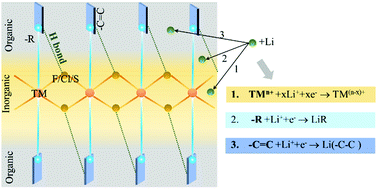Assembling organic–inorganic building blocks for high-capacity electrode design†
Abstract
Metal–organic electrode materials have exhibited extraordinary promise for green and sustainable electrochemical energy storage devices, but usually suffer from low specific capacity, and poor cycling stability and rate capability because of limited active sites at organic functional groups. To address this issue, activating transition metals and carbon conjugate rings has become significantly effective to make transferred electrons dispersed in the whole molecule. In this work, we demonstrate that assembling inorganic–organic building blocks into “local” composite metal–organic materials could synergistically activate transition metal ions and carbon conjugate rings to operate cationic and anionic redox, respectively. Based on first-principles calculations, the composite inorganic–organic material FeF3(4,4′-bpy) generates 8-electron transfer redox processes of Fe3+ + 2e− → Fe+ and 2 –C![[double bond, length as m-dash]](https://www.rsc.org/images/entities/char_e001.gif) N– + 2e− → 2 (–C–N–)− and 4 –C
N– + 2e− → 2 (–C–N–)− and 4 –C![[double bond, length as m-dash]](https://www.rsc.org/images/entities/char_e001.gif) C– + 4e− → 4 (–C–C–)−, achieving a high specific capacity of 796.7 mA h g−1, maintaining structural stability, and reducing the band gap. The strongly electronegative F-ions in inorganic structure [FeF4]2− play an important role in making highly oxidized Fe3+ through forming a strong ligand field and electrochemically activating –C
C– + 4e− → 4 (–C–C–)−, achieving a high specific capacity of 796.7 mA h g−1, maintaining structural stability, and reducing the band gap. The strongly electronegative F-ions in inorganic structure [FeF4]2− play an important role in making highly oxidized Fe3+ through forming a strong ligand field and electrochemically activating –C![[double bond, length as m-dash]](https://www.rsc.org/images/entities/char_e001.gif) C– via electrostatic interaction with Li+. In addition, electrochemical measurements also reveal that the central metal Fe, and –C
C– via electrostatic interaction with Li+. In addition, electrochemical measurements also reveal that the central metal Fe, and –C![[double bond, length as m-dash]](https://www.rsc.org/images/entities/char_e001.gif) C and –C
C and –C![[double bond, length as m-dash]](https://www.rsc.org/images/entities/char_e001.gif) N bonds of the FeF3(4,4′-bpy) electrode are the active sites for Li-ion storage to deliver a high reversible capacity (793.1 mA h g−1 at 50 mA g−1) and excellent rate capability, which are echoes of the DFT calculations. Through this design principle, we found a series of high-capacity metal organic electrode materials such as MnF3(4,4′-bpy) (799.6 mA h g−1) and VF3(4,4′-bpy) (811.7 mA h g−1).
N bonds of the FeF3(4,4′-bpy) electrode are the active sites for Li-ion storage to deliver a high reversible capacity (793.1 mA h g−1 at 50 mA g−1) and excellent rate capability, which are echoes of the DFT calculations. Through this design principle, we found a series of high-capacity metal organic electrode materials such as MnF3(4,4′-bpy) (799.6 mA h g−1) and VF3(4,4′-bpy) (811.7 mA h g−1).



 Please wait while we load your content...
Please wait while we load your content...